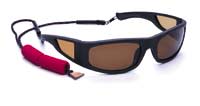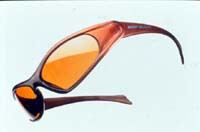The Lens-Performance
Connection
How emphasizing lens features can boost sport
sunwear sales
By Marcy Bruch
Whether someone�s passion is running, biking, golfing, or skiing, you can bet they�ll want to look the part by donning a pair of sleek sport wraps. Still, looking cool is only half the equation. In order for sport sunwear to truly make the grade, it needs to perform just as well as the sports enthusiast who wears it. And while frame fit is important, the lenses pack the most functional punch into sport sunwear.
The lens material, color, coatings, and interchangeable capabilities can all help raise the bar to give an athlete that extra competitive edge. The question is, how does a dispenser present features and benefits to customers so they clearly understand the lens-performance connection? What follows are a few suggestions from those who know.
|
|
|
|
Maui Jim�s Titanium Sport combines lightweight frames with polarized lenses. |
Determining lens material
Craig Dolloff, vice president of global sales evangelism for Sunglass Hut, travels throughout the country to train Sunglass Hut sales associates on how to sell sport sunwear. Since he previously taught sales people at Maui Jim, he is well versed in communicating the features and benefits of lenses.
�The first thing a sales associate must know is the difference between the three lens materials�glass, CR 39, and polycarbonate,� says Dolloff. �For extreme sports, glass lenses are not an advisable option because of breakage. CR 39 may be thicker than glass but it�s also more impact resistant, so it�s better suited for sports activities. In fact, the way it got its name is because it was the 39th formulation that passed Columbia Resin�s (CR) test to make aircraft windshields 50 times more impact resistant than traditional windshield glass,� Dolloff points out. �Polycarbonate is even more impact resistant than CR 39 as well as lighter weight, so it�s the best lens material option for active sports�even though it�s the most expensive.�
Still, glass lenses have a place in the sporting arena, too. �Since glass offers the most visual acuity, if it�s photochromatic and has an AR coating, it�s ideal for activities like deep water fishing, where variable light conditions can be overcome through the photochromatics, and an AR coating further enhances visual clarity,� says Paula Humo, product manager for Serengeti, a division of Bushnell Performance Optics. Similarly, glass often features a polarized filter that is sandwiched between two glass lenses to achieve optimum visual acuity that is combined with glare-cutting polarization.
Besides considering the lens material, Dolloff says that dispensers should show consumers the 100 percent UVA and UVB protection stickers, as well as any ANSI standard information that might appear indicating level of impact resistance and whether a lens is recommended for general use or other specific purposes. �This is a way of adding to your credibility by pointing out you are selling product that has been tested for their safety,� he says.
Another issue to keep in mind�especially when it comes to sport wraps�is that the lenses be prismatically correct and decentered at the focal point area so there is no visual distortion. �For golfers and tennis players, visual acuity is particularly important because their game is about hitting a ball precisely,� Dolloff says.
|
|
|
|
Serengeti�s St. Croix features side shields. |
|
Prescription as added value
Bill MacGillvray, an optician at North Portland Optical in Portland, Ore., agrees that one of the most important issues when dispensing prescription sport sunwear is to make sure there�s no distortion. �This is especially crucial when doing prescription lenses for wrap frames,� he says, �because the lenses tend to get thicker in the center where the focal point is, and that can create distortion.�
Through much trial and error, MacGillvray developed a method for edging prescription lenses in his own lab specifically for wrap frames. �Although companies like Oakley now have prescription programs where you send frames out to the manufacturers, the turnaround time is about two weeks,� says MacGillvray. �When I do it in-house, it only takes five days. The quicker turnaround time raises our level of service. So even though there are more lens redos, offering that added-value service pays off over the long run. What�s more, giving the consumer prescription sport sunwear is yet another way we as optical retailers can differentiate ourselves from the sunglass specialty shops. So one of the first questions I ask customers who are looking for sport sunwear is whether or not they wear prescription eyewear.�
Qualifying customer lifestyle
Once a dispenser has zeroed in on the most appropriate lens material and whether or not the customer needs a prescription, the next step is to ask questions about what kind of sport they will be engaging in. This will determine whether a polarized lens would be beneficial, and what color lens would best enhance their performance.
Terry Sutherland, an optician for Eyecare Services of Group Health in Seattle, Wash., has a significant customer base of mountaineering enthusiasts and maintains there�s a big difference between brown and gray polarized lenses. �I have a lot of customers who hike up Mount Rainer and Mount McKinley. Because of the high altitude, it is extremely light, creating a whiteout condition. In that instance, we recommend gray polarized lenses because it�s the color that most effectively blocks out the yellow light, which creates that whiteout effect. We even darken the gray tint a couple of shades for prescription lens,� he says. To make sure these gray polarized lenses work, he uses a spectrometer so he can check how much of the light is blocked out. �We also have demonstrators so mountaineers can witness how the lenses will enhance their vision clarity when they are in such extreme light conditions,� says Sutherland.
|
|
|
|
Body Glove style BG20, with Sola lenses, from Allision S.p.A. fits snugly on the face. |
Comfort comes first
Bev Rouleau, owner of International Optique in Denver, Colo., is also a believer in using glare demonstrators, but for another reason. �Some people simply feel uncomfortable wearing either the gray or brown polarized lenses. I�ve observed that women especially complain they feel closed in when they wear the gray polarized lenses. So I always have people try on both the gray and brown polarized lenses, have them look into the glare demonstrator, and ask them which color feels more comfortable,� she says. �For the most part, I find women prefer the brown polarized lenses and men prefer the gray polarized lenses. If they have no preference, I then start asking them questions about the kind of sporting activity they�ll be engaging in and recommend accordingly. But their general comfort level with the color must take priority.�
For skiing enthusiasts, Rouleau recommends the brown polarized lenses because they enhance contrast, which better highlights the hills and valleys of moguls that prevail on ski slopes. �Although gray polarized lenses offer truer color, they make the landscape seem more flat,� she says.
Rouleau is also adamant about not dispensing glass lenses to skiers. �Even if they ask for glass lenses, I won�t sell it because I don�t want to be held liable,� she says.
|
|
|
|
Oakley�s Pro M wrap is designed specifically for golfers |
|
Lens coatings
Other performance-enhancing features that dispensers can point out to athletes include finishes such as anti-reflective coatings and flash-mirror treatments. �Flash-mirror coatings are useful because they enable athletes to see better into the depths of shadows,� says Dolloff of Sunglass Hut. �They�re great for cyclists because often they are biking in sunlight one minute, then racing under a forest of trees the next. The disadvantage to flash-mirror coatings is they often give people sunburned noses,� he counters. �Golfers and tennis players benefit through AR coatings because it minimizes distortion by stopping eye reflection on the back part of the lens.� he says.
|
|
|
| Timberland�s Ti Shield for Rem Eyewear features Sola lenses that block blue light for greater visual clarity |
Interchangeable lens options
Since many people are weekend warriors who engage in a variety of sports activities depending upon the season, more manufactures are offering sport frames with interchangeable lenses. �Many of these interchangeable systems include orange or yellow lenses that are great to wear on cloudy days because they brighten the landscape and enhance contrast,� says MacGillvray of North Portland Optical. �One of my customers who skis told me he popped them out and changed lenses while on a chair lift when it started getting cloudy,� he adds. �I think interchangeable lens systems offer a lot of bang for the buck for the cross-trainer,� he maintains.
Walk the walk
Still, Peter Duff, co-owner of Duff Opticians in Brattleboro, Vt., believes the best person to sell sportswear is someone who is a sports enthusiast himself. �If you know what some of the visual challenges are when someone is engaging in a particular sport, then you can anticipate what kind of features and benefits will interest them the most,� he says. For example, because Vermont draws a lot of skiers, Duff began selling ski goggles with slots behind the lenses to slip in prescription lens inserts. �There are also vents around the goggles to prevent fogging. For $115, a skier can wear goggles that are customized to his prescription, protect his eyes from the wind, and don�t fog up. As a skier myself, I know these features are worth their weight in gold,� he says.
|
|
|
|
Nike�s Tarj R for Marchon has interchangeable lenses that are ideal for cross-trainers. |
|
Other selling tips
However, since every dispenser is usually not a passionate athlete, Dolloff advises optical retailers to use whatever P-O-P materials manufacturers offer to better tell a sport lens story. �You want to pull them into the sale, not push them,� he advises, �because people hate to be sold, but they love to buy. You can start by simply asking them what sport sunwear they�re currently wearing. If they whip out a pair of Maui Jims and they tell you they love them, then direct them to the very latest styles from Maui Jim and say, �well then you�re really going to love these.�
�Don�t challenge their emotional bond to a particular brand. If they�re open to buying something else, then show them something that addresses the needs of their athletic activity. Utilize whatever demonstrators a manufacturer provides to get the lens performance message across.�
And Dolloff�s final word to the wise: �Just remember, strong merchandising loads the gun. It�s up to the salesperson to fire it.�









